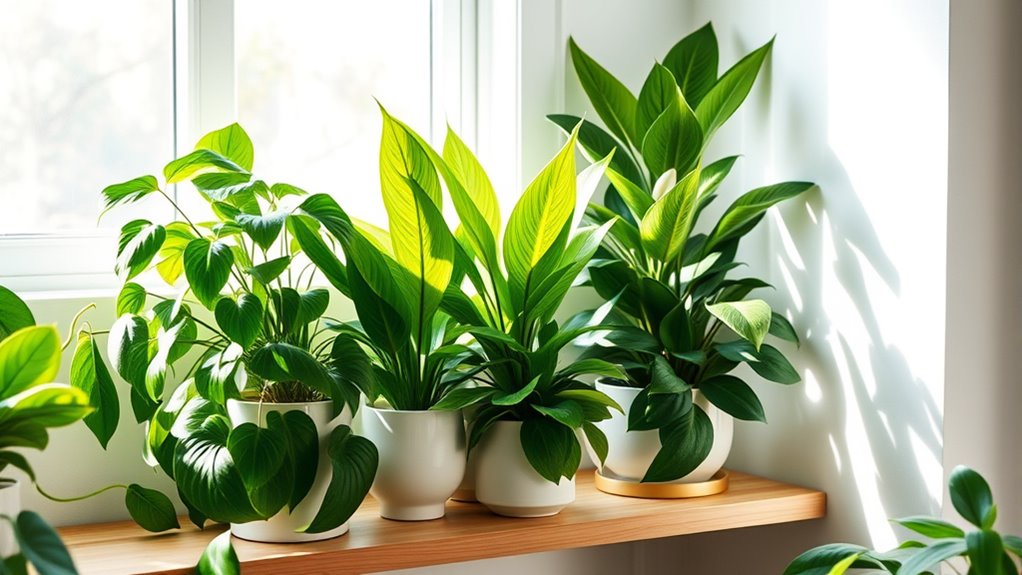If you want houseplants that naturally reduce VOCs and improve indoor air quality, consider options like snake plants, peace lilies, Boston ferns, areca palms, and rubber plants. These plants actively filter toxins like formaldehyde, benzene, and xylene while adding a calming vibe to your space. With proper care, they keep your air clean and vibrant. Keep exploring to discover how to care for each plant and maximize their benefits.
Key Takeaways
- Many houseplants like Snake Plant, Peace Lily, and Boston Fern effectively filter VOCs such as formaldehyde and benzene.
- Proper plant care, including consistent watering and indirect sunlight, enhances their air-purifying efficiency.
- Plants like Areca Palm and Rubber Plant absorb toxins through leaves and roots, improving indoor air quality naturally.
- Additional air-purifying options include Aloe Vera and Chinese Evergreen, which also offer health benefits and aesthetic appeal.
- Regular maintenance, such as dusting leaves and monitoring soil moisture, ensures optimal plant health and continuous air purification.
Snake Plant (Sansevieria)
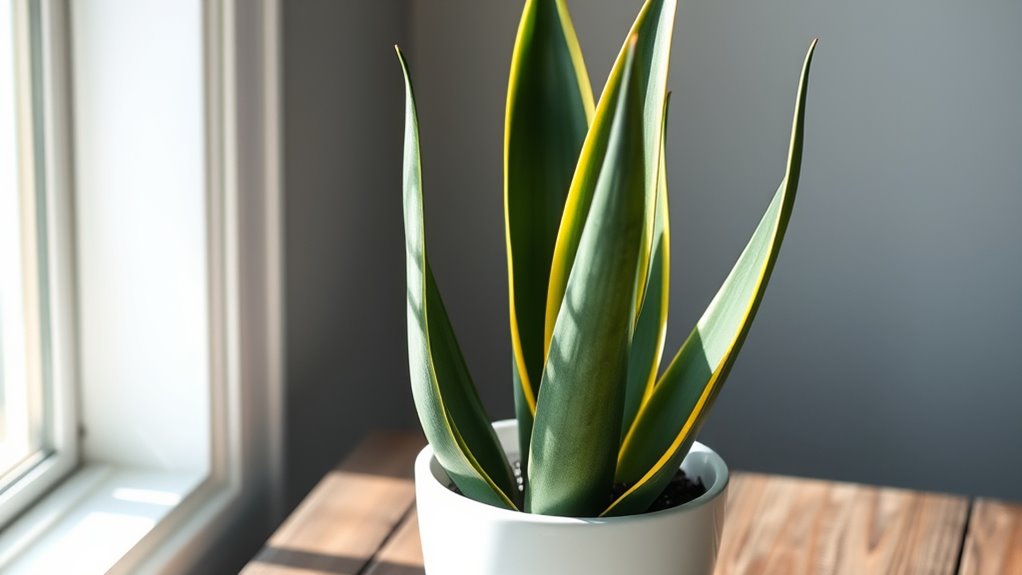
Have you ever wondered how some houseplants can improve your indoor air quality effortlessly? The snake plant (Sansevieria) is a perfect example. Its hardy nature means you don’t need to worry much about plant health, as it adapts well to various conditions. To keep it thriving, monitor soil moisture; it prefers dry soil and can tolerate infrequent watering. Overwatering can lead to root rot, so ensure the soil dries out between waterings. This resilience makes it an ideal choice for busy spaces or beginners. The snake plant also actively filters out toxins, helping to purify your air naturally. With minimal care and proper soil moisture management, your snake plant will stay healthy and continue contributing to a vetted fresher, cleaner indoor environment.
Peace Lily (Spathiphyllum)
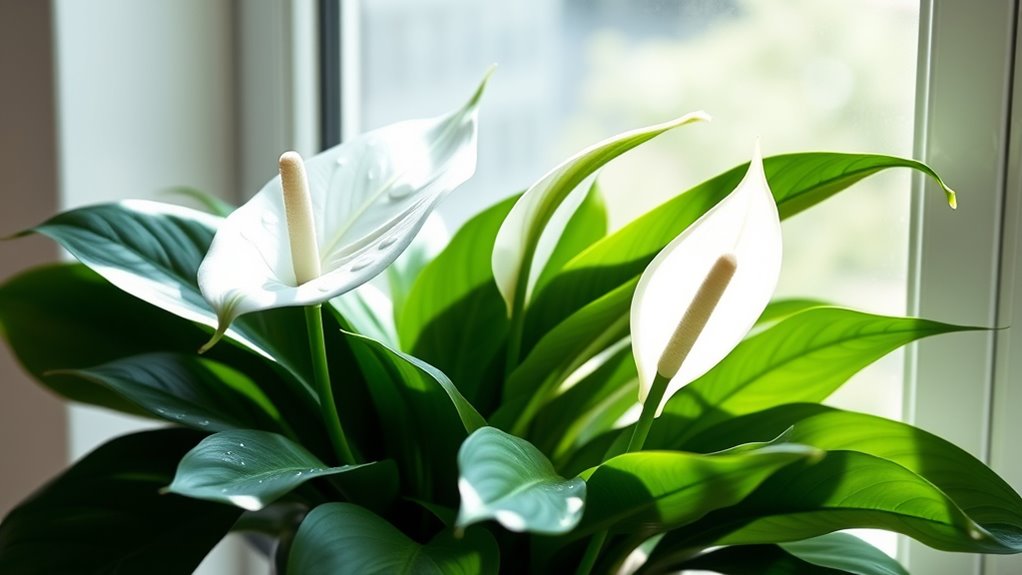
The Peace Lily (Spathiphyllum) is an elegant houseplant that naturally helps improve indoor air quality. Its plant growth habits feature lush, dark green leaves with graceful white flowers, making it a stylish addition to any space. To thrive, you need to manage soil moisture carefully; keep the soil consistently moist but not waterlogged. This plant prefers indirect light, which supports healthy growth and flowering. Proper soil moisture management prevents root rot and encourages vibrant foliage. The Peace Lily’s ability to filter VOCs and other toxins makes it a practical choice for improving air quality. Regular watering, combined with good drainage, ensures the plant maintains ideal moisture levels. Additionally, monitoring plant health can help detect early signs of stress or disease, ensuring your Peace Lily continues to flourish. With proper care, your Peace Lily will flourish and continue purifying your indoor environment.
Boston Fern (Nephrolepis Exaltata)

A Boston Fern (Nephrolepis exaltata) naturally filters airborne toxins and boosts indoor air quality with its lush, feathery fronds. Its air purifying benefits help remove common VOCs like formaldehyde and xylene, making your space healthier. Plus, this fern excels at indoor humidity control, adding moisture to dry environments and reducing dust and static. As you care for it, you’ll notice how its vibrant foliage creates a calming, natural atmosphere. Boston Ferns thrive in indirect light and moist soil, so keep the environment humid to support its health. By placing this plant in your home, you not only enjoy its aesthetic appeal but also actively improve air quality and humidity levels—creating a more comfortable living space.
The benefits of indoor plants are enhanced when choosing species like the Boston Fern that are known for their air-purifying properties.
Areca Palm (Dypsis Lutescens)
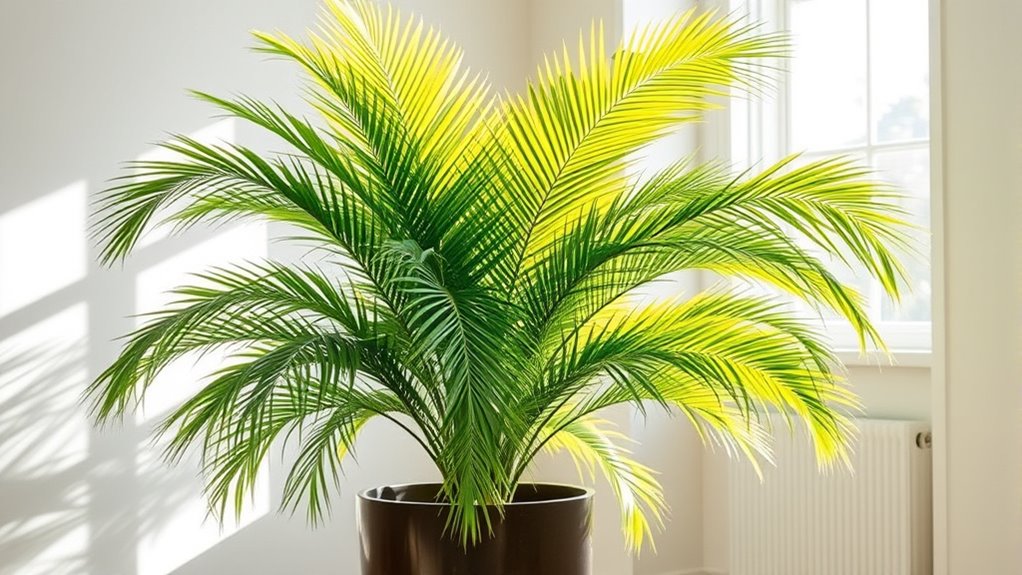
The Areca Palm is an excellent choice for improving indoor air quality, as it effectively filters out VOCs and other airborne toxins. It’s also easy to care for, requiring minimal maintenance to stay healthy and vibrant. Plus, its graceful, feathery fronds add a lush, attractive touch to any space. Regular watering and proper lighting help ensure the plant remains healthy and effective at air purification plant maintenance tips.
Air Purification Capabilities
Because it’s an effective natural air purifier, the Areca Palm (Dypsis lutescens) actively removes VOCs and improves indoor air quality. Its air purification science reveals that this plant absorbs airborne toxins through its leaves and roots, trapping pollutants like formaldehyde, xylene, and toluene. The Areca Palm uses VOC reduction techniques by filtering and breaking down harmful chemicals, releasing cleaner, fresher air. Its large, lush fronds increase surface area for pollutant absorption, making it highly efficient. You benefit from a healthier environment as it continuously works in the background, reducing airborne contaminants. This plant’s natural properties help elevate indoor air quality without the need for artificial filters or devices, making it a practical choice for anyone seeking a cleaner, more breathable space.
Easy Maintenance Needs
Fortunately, caring for the Areca Palm (Dypsis lutescens) is straightforward, making it suitable even for beginners. You should water it regularly, about once a week, allowing the top inch of soil to dry out between watering. This prevents overwatering and root rot. The soil requirements are simple: a well-draining potting mix that retains some moisture but doesn’t stay soggy. Make certain your plant is in a location with bright, indirect light, which helps it thrive with minimal fuss. The Areca Palm is tolerant of occasional neglect, so you don’t need to worry about frequent pruning or complex care routines. Additionally, choosing plants with air-purifying properties can further enhance your indoor environment. Overall, its easy maintenance needs make it an excellent choice for anyone looking to add greenery that’s both beautiful and low-maintenance.
Aesthetic Indoor Appeal
With its feathery, arching fronds and vibrant green hue, the Areca Palm instantly elevates the aesthetic of any indoor space. Its elegant, bushy form fits well into various plant arrangements, whether placed alone as a statement piece or grouped with other greenery for a lush display. When considering color coordination, the bright green of the Areca Palm complements neutral tones like whites, beiges, and grays, adding a lively contrast. You can position it near seating areas or in corners to create a natural, inviting atmosphere. Its graceful fronds soften sharp lines and add visual interest without overwhelming your decor. Overall, the Areca Palm enhances your indoor environment by blending aesthetic appeal with natural beauty, making your space feel more vibrant and welcoming.
Rubber Plant (Ficus Elastica)
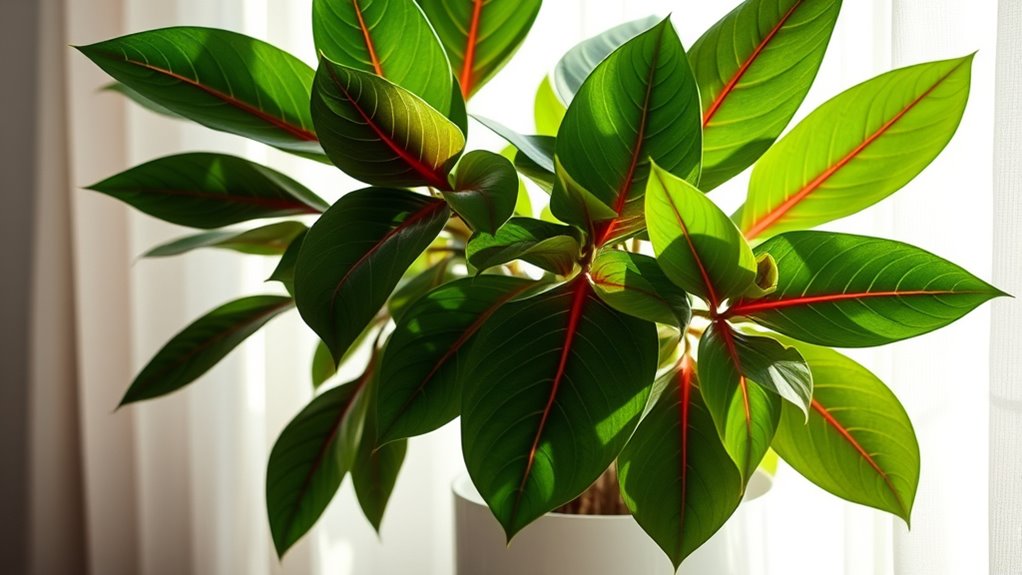
The rubber plant is highly effective at absorbing VOCs, making it a great choice for improving indoor air quality. To keep it healthy and maximize its filtration ability, you’ll want to follow specific care and maintenance tips. Regular watering, proper lighting, and occasional pruning are key to ensuring your rubber plant thrives and continues to purify your air. Additionally, selecting a high-quality soil can support optimal growth and enhance its VOC absorption capacity.
VOC Absorption Efficiency
Have you ever wondered how effective the rubber plant (Ficus elastica) is at removing VOCs from indoor air? Its VOC removal mechanisms rely on plant absorption rates that enable it to filter airborne toxins. The rubber plant absorbs VOCs through its leaves and roots, breaking down harmful compounds via metabolic processes. While its absorption rate isn’t as rapid as some other houseplants, it still plays a meaningful role in improving air quality over time. The plant’s thick, waxy leaves help trap VOC molecules, and its root system enhances overall absorption capacity. Consistent presence and healthy growth increase its VOC removal efficiency. Additionally, plant physiology influences how effectively the rubber plant can absorb and metabolize airborne toxins. Overall, the rubber plant offers a natural, steady method for reducing indoor VOC levels, making it a valuable addition to your air-purifying plant collection.
Care and Maintenance Tips
To keep your rubber plant healthy and maximizing its air-purifying capabilities, you should provide it with proper care and maintenance. Maintain a consistent watering frequency, allowing the top inch of soil to dry out between waterings to prevent overwatering. During the growing season, watering once every 1-2 weeks is usually sufficient, but adjust based on your environment. The rubber plant thrives in bright, indirect sunlight, so place it near a window with filtered light. Avoid direct sun, which can scorch its leaves. Proper sunlight encourages healthy growth and vibrant leaves. Regularly wipe dust from its leaves to optimize photosynthesis. With attentive watering and adequate sunlight, your rubber plant will stay healthy, vibrant, and effective at purifying your indoor air.
Aloe Vera (Aloe Barbadensis Miller)
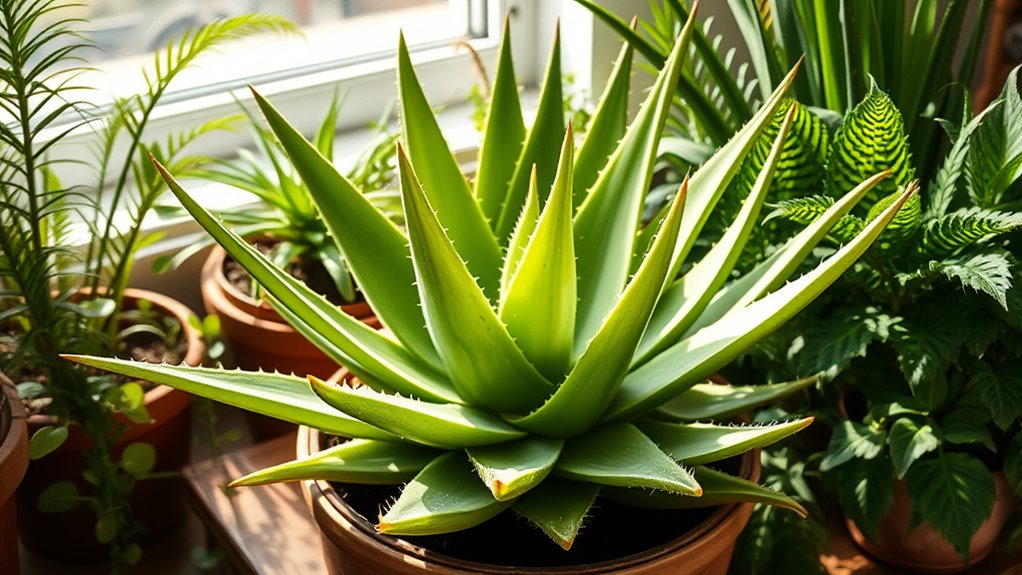
Did you know that Aloe Vera (Aloe barbadensis Miller) not only soothes skin but also actively improves indoor air quality? This plant is a natural remedy for many ailments, making it a popular choice for plant healing. Its thick, fleshy leaves contain compounds that help filter out VOCs like formaldehyde and benzene from the air. By keeping an Aloe Vera plant indoors, you create a healthier environment and enjoy its decorative appeal. Plus, you can use the gel from its leaves as a natural remedy for cuts, burns, and skin irritation. Its low-maintenance nature makes it perfect for beginners. Aloe Vera’s ability to purify air while offering healing benefits makes it a versatile addition to your home or office space.
Chinese Evergreen (Aglaonema Modestum)

The Chinese Evergreen (Aglaonema modestum) is a popular houseplant known for its striking foliage and air-purifying abilities. It actively improves indoor air quality by filtering toxins like formaldehyde and benzene, making your living space healthier. Its lush, variegated leaves add vibrant texture to any room, enhancing visual appeal and creating a calming environment. Imagine the plant sitting on a shelf or corner, its leaves spreading out like a living artwork. Here’s a visual to help you picture it:
| Foliage Color | Leaf Pattern |
|---|---|
| Deep Green | Silver Variegation |
| Light Green | Subtle Stripes |
| Variegated | Contrasting Edges |
This easy-care houseplant offers both aesthetic and health benefits, making it a valuable addition to your home.
English Ivy (Hedera Helix)
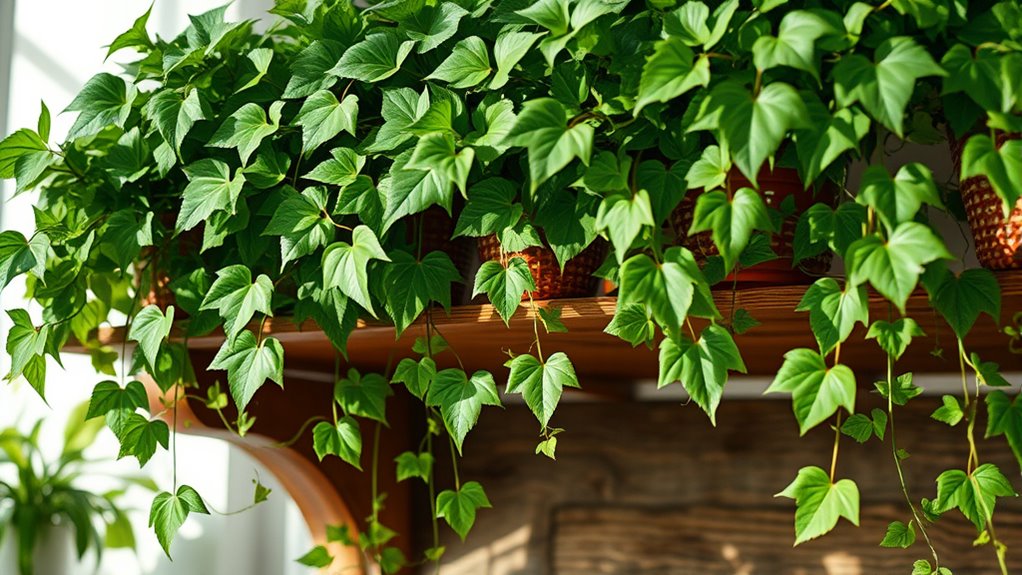
English Ivy (Hedera helix) stands out as an effective natural air purifier that can enhance your home’s indoor environment. Its rapid growth patterns allow it to quickly cover walls or containers, making it a versatile decor option. You’ll notice its trailing vines and dense foliage add a lush, green touch to any space. However, toxicity concerns are important to keep in mind; English Ivy is toxic to pets and children if ingested, so placement matters. Despite this, its ability to absorb airborne toxins like VOCs makes it a popular choice for improving indoor air quality. Regular pruning can help manage its growth and prevent overgrowth, keeping your space safe and vibrant. Incorporating plants with air filtration benefits like English Ivy can contribute to healthier indoor environments. With proper care, it’s a beautiful, functional addition to your home.
Bamboo Palm (Chamaedorea Seifrizii)
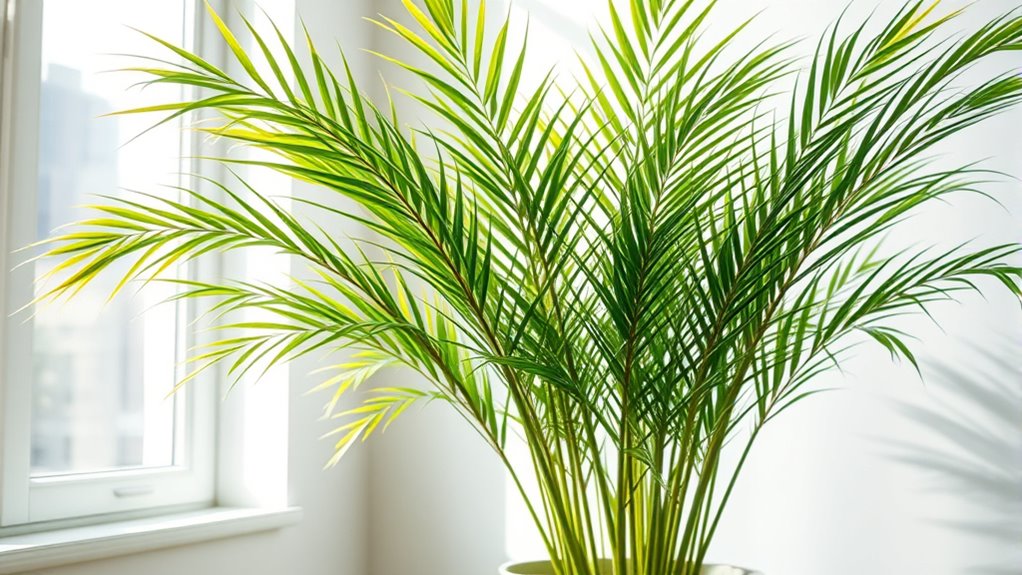
Bamboo Palm (Chamaedorea Seifrizii) is a popular choice for natural air purification because it effectively filters airborne toxins, including VOCs. This plant thrives in indoor environments with moderate to high humidity, helping to maintain ideal indoor humidity levels naturally. Its lush foliage not only enhances aesthetic appeal but also promotes better air circulation, which is essential for dispersing purified air throughout your space. As the bamboo palm absorbs VOCs, it releases moisture, making it especially beneficial in dry indoor conditions. Keep it in bright, indirect light and ensure the soil stays moist but not waterlogged. By doing so, you’ll support its ability to purify your air and improve overall indoor air quality effortlessly. Understanding plant benefits can help you choose the best options for your home environment.
Frequently Asked Questions
Which Houseplants Are Safest for Households With Pets?
When choosing pet-safe plants, you prevent toxic plant risks that could harm your pets. Opt for pet-safe plants like spider plants, Boston ferns, and cat grass, which are generally safe for households with animals. Always double-check specific plant safety info, as some common houseplants can pose dangers. Keeping pet-safe plants ensures your home stays beautiful and your furry friends stay healthy and safe.
How Often Should I Water These Voc-Reducing Plants?
Think of watering frequency as a gentle dance with your plants; too often, and you drown their roots, too little, and they wither. You should check soil moisture regularly—stick your finger about an inch deep. If it feels dry, give your plants a drink. Usually, watering once a week works well, but adjust based on your home’s humidity and the plant’s needs. Keep their roots happy, and they’ll thrive!
Do These Plants Require Direct Sunlight or Indirect Light?
You wonder about the light preferences and placement considerations for these plants. Typically, they thrive best in bright, indirect light, which helps them grow healthy without the risk of leaf burn. Avoid direct sunlight, as it can scorch their leaves. Position them near east or west-facing windows to ensure they get plenty of gentle light. Adjust placement based on how much light your space naturally offers for ideal growth and air purification.
Can These Plants Help Reduce Indoor Allergies?
Think of your indoor air as a crowded room filled with airborne allergy triggers. While houseplants can help filter some pollutants, they might also pose plant allergen risks, potentially aggravating airborne allergy triggers for sensitive individuals. If you’re concerned about allergies, choose hypoallergenic plants and keep them clean. These plants can help create a fresher environment, but they aren’t a guaranteed shield against allergy symptoms.
Are There Any Maintenance Tips to Maximize Air Purification?
To maximize air purification, you should focus on proper plant care. Keep your plants healthy by watering them appropriately and providing adequate light, which boosts their ability to filter air. Regularly remove dust from leaves to improve their function, and avoid over-fertilizing, as excess nutrients can harm the plant. Good plant care directly enhances air quality, ensuring your houseplants effectively reduce VOCs and improve your indoor environment.
Conclusion
Think of these houseplants as your indoor guardians, each one a tiny hero battling VOCs and purifying your air. Just like a team of vigilant knights, they stand guard in your home, quietly working to keep your environment fresh and healthy. By inviting these green allies into your space, you create a sanctuary where your well-being flourishes amidst the calming presence of nature’s own defenders. Let your home breathe easier, and enjoy the peaceful harmony they bring.
